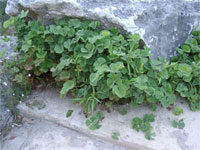Wild About Texas – June, 2010

Resurrection fern. Photo by Lynn and Campbell Loughmiller.
Native Garden Ferns

River fern. Photo by David Mahler

Maidenhair fern planted along a created stream. Photo by David Mahler

Wavy cloakfern at the Wildflower Center. Photo by David Mahler

Bigfoot water clover at the Wildflower Center. Photo by David Mahler

Bigfoot water clover in shallow water. Photo by Joe Marcus.

Christmas fern. Photo by Andy and Sally Wasowski.
In the suffering heat of Texas summers, ferns nestled into a shady garden, with their attractive dissected leaves in all tones of green, offer a refreshingly cool and luxuriant textural accent. We mostly think of ferns for shade, but of Texas’ 100-plus species, there are more xerophytic (arid-loving) ferns than ferns for woodlands. It’s entertaining to watch Northerners respond, baffled if not thrilled, at the scene of ferns tucked between rocks and prickly pears.
Ferns look their best neighboring plants with bold, rounded leaves or with fine-textured foliage. They are especially effective in pots, or silhouetted against boulders or against smooth or textured walls. Shade-loving ferns combine nicely with Turk’s cap (Malvaviscus arboreus var. drummondii), dwarf palmetto (Sabal minor), tropical sage (Salvia coccinea), cedar sage (S. roemeriana), and sedges.
For sunny, arid groupings, plant them with drought-tolerant native ornamental grasses like Mexican feathergrass (Nassella tenuissima), side-oats, or hairy grama (Bouteloua curtipendula, B. hirsuta). Silver ponyfoot (Dichondra argentea), prickly pears (Opuntia spp.) and smaller cacti also work nicely, as do small-flowering species such as blackfoot daisy (Melampodium leucanthum) and penstemons.
Following is a list of a few commercially available fern options. Casa Flora (www.casaflora.com) is a wholesale-only vendor with a huge selection of native and non-native species. Local garden centers are also good sources.
Resurrection fern (Selaginella lepidophylla) — During dry spells, desiccates into dormant balls only to rehydrate back to bright, lush green after rains. Specimens can be seen in the cactus garden at Sul Ross University in Alpine. Be wary of plants that may be wild collected. Native to West Texas. Flat, spreading rosettes, 1-2” high when hydrated, spreading to 10” wide.
American royal fern (Osmunda regalis) — Showy spore fronds on large plants. Tolerates shade or sun with enough water. Handsome, lacey foliage. Easy to grow in wet acidic soils. Occurs in eastern third of the state. Deciduous; 2-4’.
Southern wood (river) fern (Thelypteris kunthii) — Popular, hardy and easy to grow. Eastern two thirds of Texas. Deciduous; 2-3’.
Southern maidenhair fern (Adiantum capillus-veneris) — Black stems set off round chartreuse leaflets. Grows well on limestone and alkaline soils and is ideal on the edges of ponds. Keep shaded and moist; it likes the sound of dripping water. Found throughout the state. Deciduous; 1-2’.
Wavy cloakfern (Astrolepis sinuata, aka Notholaena sinuata) — Light-colored, gray-green plants require dry, well-drained limestone and igneous-based soils in full to part sun. Western half of Texas. Semi-evergreen; 6-15”.
Water clovers (Marsilea vestida, M. macropoda) — A true fern that looks like four-leaf clover! Grow in moist soil or shallow water in full sun or part shade. Throughout most of the state. Deciduous; 12”.
Christmas fern (Polystichum acrostichoides) — Resembles Boston fern. Thrives in rich, moist conditions, as well as dryer areas. Occurs in far East Texas. Green in winter and used for holiday decorations. 12-24”.
For more information about Texas native plants, visit the Wildflower Center’s website at www.wildflower.org.
About the author: Andrea DeLong-Amaya is the director of horticulture at the Lady Bird Johnson Wildflower Center in Austin.
REFERENCES
Correll, D. S., and M. C. Johnston. 1979. Manual of Vascular Plants of Texas. The University of Texas at Dallas, Richardson, Texas.
Olsen, S. 2007. Encyclopedia of Garden Ferns. Timber Press, Portland, Oregon.
Turner, B.L., and H. Nichols, G. Denny, and O. Doron. 2003. Atlas of the Vascular Plants of Texas Volume 2. Botanical Research Institute of Texas, Fort Worth, Texas.
Yarborough, S.C. and A.M. Powell. 2002. Ferns and Fern Allies of the Trans Pecos. Texas Tech University Press. Lubbock, Texas.
Casa Flora Sales Catalog. Hardy and Tropical Ferns. Dallas, Texas. www.casaflora.com.

